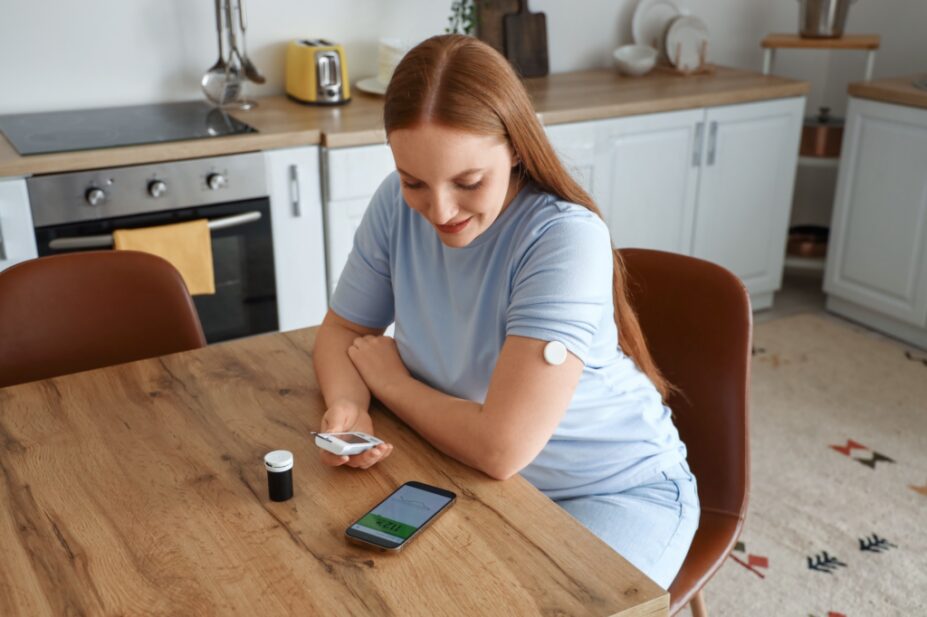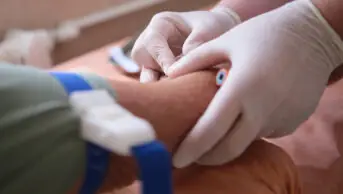
Shutterstock.com
After reading this article, you should be able to:
- Describe the benefits and challenges of using digital therapeutics in healthcare;
- Identify ways pharmacists can integrate digital therapeutics into their practice;
- Outline the early value assessment for MedTech;
- Summarise the digital therapeutics already in use and potential future developments.
Introduction
Chronic conditions are the leading cause of global mortality and management of these conditions is associated with a specific set of challenges[1]. These include medication adherence, the need for self-management, adaptation to lifestyle and behavioural changes, and the need for personalised care, ongoing monitoring and treatment adjustment (such as in diabetes)[2–4].
Digital therapeutics (DTx) — evidence-based interventions driven by high-quality software programs, to prevent, manage or treat medical conditions — have the potential to address these challenges. DTx can broaden treatment options available to patients and healthcare professionals, as well as offering new ways of accessing care.
DTx encompasses a wide range of product forms and indications that have already been shown to be significantly effective and include[5]:
- Mobile applications (apps) to support diabetes management[6];
- Game-based treatments for attention deficit hyperactivity disorder (ADHD)[7];
- Cognitive behavioural therapy-based platforms for managing depression, anxiety and insomnia[8,9].
These interventions are certified by regulatory bodies to support product claims regarding risk, efficacy and intended use, and may require a prescription. They differ from other digital health technologies (e.g. wellness and support tools such as tracking and educational applications) because they deliver therapeutic interventions, adhere to strict regulatory standards and require the publication of robust trial data to support claims that relate to treating, managing or preventing disorders. Other digital health technologies may not deliver a therapeutic intervention (e.g. they might simply track data or provide education) or do not deliver evidence-based interventions (see Figure[5]).
The vision for integrating digitally-enabled healthcare as standard practice throughout the NHS was outlined in the ‘NHS long-term plan’ in January 2019[10]. Decision support tools and artificial intelligence (AI) have been identified as main priorities that will help drive NHS digital transformation to assist healthcare professionals, including pharmacists and pharmacy teams, to adhere to best practices, eradicating unjustified variances in healthcare and helping patients oversee their wellbeing and medical conditions[10]. In addition, employing predictive methodologies to aid regional health systems in strategising healthcare services for their respective populations is another priority outlined in the ‘NHS long-term plan’[10].
The role of pharmacists may include: identification of clinical needs for which DTx are an optimal treatment option; advice on the therapies’ indications, safety and effectiveness; provision of education related to the product and overviews of expected outcomes of use; a review and assessment of patient-specific data and outcomes; and optimisation of therapy after an outcome evaluation.
The benefits of digital therapeutics
DTx has the potential to benefit both patients and healthcare systems, including improving access to healthcare and potentially reducing the need for in-person visits, which can help alleviate resource constraints and long treatment waiting times[11,12]. They can also provide personalised treatment, tailored coaching and immediate feedback for improved patient outcomes. For example, a mobile app designed to assist patients in self-management of diabetes through personalised coaching, blood glucose analysis and supporting medication adherence resulted in statistically significant improvements in measures of diabetes control after three months of use[6,13].
DTx may address adherence challenges and enhance self-efficacy by helping individuals better understand their conditions, engage in their care and improve treatment adherence[14]. For example, a mobile health programme that was designed to support the management of asthma by using inhaler sensors to record and monitor inhaler usage, review symptoms and deliver personalised information to help manage and reduce symptoms via a smartphone app, demonstrated significant improvements in adherence to medications and improved asthma-related outcomes during a six-month randomised controlled study of 125 participants with asthma. Of these, 67 received sensors, access to apps that provided visualisations of their data, prompts to promote adherence and personalised guideline-based education[15,16].
Challenges relating to use
One challenge associated with the use of DTx is that patients and healthcare professionals need to be able to differentiate DTx from general health and wellbeing applications, enabling them to identify the DTx that have evidence-based safety and efficacy claims[12].
Another potential challenge is ensuring equitable access to these treatments. Since DTx are delivered via digital platforms, such as mobile phones or tablets, patients must have access to and understand how to use such devices[14]. There may be differences in app versions as DTx develop over time and this may cause discrepancies between patients who use the technology, especially if patients find it difficult to use[12].
Although the number of internet non-users — adults who have either never used the internet or have not used it in the past three months — has decreased, there were still 5.3 million internet non-users in the UK in 2018, equating to 10.0% of the adult UK population[17]. Furthermore, 8% of people in the UK (4.3 million people) are estimated to have zero basic digital skills, as determined by the Tech Partnership Basic Digital Skills framework[17]. Digital exclusion does not just affect adults — the same data show that 12% of those aged 11–18 years (700,000 people) reported having no internet access at home from a computer or tablet, while a further 60,000 people reported having no home internet access at all[17].
Pharmacy teams can assess a patient’s needs to provide tailored recommendations and access assistance, such as helping to download, install and navigate DTx, ensuring those with limited digital literacy can access DTx.
DTx may also facilitate the collection of patient-level data. While this can be valuable for re-evaluating safety and efficacy in real-world scenarios, patients may be concerned about the security of this data and how it could be used[18].
National Institute of Clinical Excellence guidance
With the proliferation of digital health technologies, there is a need for healthcare professionals to have clear guidance on therapies that will benefit patients. NICE’s early value assessment (EVA) is aimed to address this need by providing expert opinions on which of these technologies can provide the most value for the NHS and make a difference to patients.
The EVA has three stages for the recommendation of medical technologies, including devices, diagnostics and DTx:
- Evaluation: the EVA evaluates medical technologies that address national unmet needs, with an initial focus on mental health, cardiovascular products (predicting risk of heart failure), early cancer detection and medical technologies that boost healthcare capacity because these are currently considered priority areas.
- Initial recommendation and evidence generation: once a technology is recommended for early use in the NHS, the EVA develops an evidence generation plan to detail the evidence that needs to be gathered while the digital therapeutic is in use, thereby generating real-world evidence to address evidence gaps.
- Full recommendation: based on evidence, NICE makes a full recommendation for using the technology[19].
Overall, this process allows for rapid assessment of digital products, devices and diagnostics for clinical effectiveness and value for money, allowing the NHS and patients to benefit from promising technologies as soon as possible[19].
New technology integrations in practice
A recent focus for EVA has been digital CBT for children and young people. Self-help digital CBT technologies have been recommended for use as an initial treatment option for children and young people with mild to moderate symptoms of anxiety or low mood (after an assessment for suitability[20]; see ‘Box 1: Case in practice’).
Early access to these CBT technologies has the potential to:
- Benefit patients who are unable to access treatment or are on waiting lists;
- Reduce demand on other treatment options such as face-to-face CBT;
- Prevent progression to more serious symptoms;
- Broaden the reach of treatment, since these technologies will be available to those who prefer remote rather than in-person interactions[20].
While these technologies are being used, further evidence will be generated on the level of engagement, rates/reasons for stopping treatment, symptom and impairment measures and health-related quality of life[20].
Box 1: Case in practice
Jade, aged 16 years, was referred to Child and Adolescent Mental Health Services (CAMHS) by her GP. Jade’s parents brought her to the GP owing to concerns about her persistent low mood and increasing anxiety over the past six months. They reported that she has become withdrawn, less interested in her usual activities and her academic performance had noticeably declined. Jade appeared visibly sad and reported feelings of hopelessness and guilt. She admitted to struggling with poor concentration and disrupted sleep patterns. To exclude other potential causes, the GP conducts a physical assessment and laboratory tests, which all come back normal.
Following Jade’s referral, CAMHS suggests the use of a new digital tool — the ‘Outreach Service for Children and Adolescents’, known as OSCA — which was developed to help children and young people with mild to moderate symptoms of anxiety or low mood.
OSCA, developed with the support of The National Institute for Health and Care Research Oxford Health Biomedical Research Centre, is an evidence-based, secure, online ten-week treatment programme developed to help treat social anxiety in those aged 11–19 years[20]. By using the programme, Jade will have the opportunity to work through online exercise modules (available via laptop, desktop or mobile devices), supported by weekly video calls with a practitioner to help answer questions and guide her through the treatment.
There are 8 core modules and 16 additional modules for particular fearful concerns and problems, such as leaving the past behind, self-esteem and feeling boring.
At the end of the course, Jade and her parents reported that they had noticed a significant change in her mood and she feels less anxious and depressed about life. In addition, Jade says she enjoys meeting her friends again, indicating that OSCA is also associated with functional improvement[21].
Patient education
As illustrated in the case study above, DTx can complement and extend clinical care, supporting patients and their families to be more independent. The ‘Care City Test Bed’ was a project involving the implementation of six digital innovations between June 2019 and August 2020 in east London[22]. The goal was to assess these innovations in a practical context, aiming to understand the elements that encourage both patients and staff to actively engage with digital healthcare innovations. The evaluation highlighted the following:
- The timing at which the innovation is presented can be crucial. A recommendation from a trusted individual during a face-to-face interaction may influence a person’s readiness to start using digital innovations;
- The procedure of introducing innovations and facilitating engagement can demand a significant amount of time and resources. Programs should allocate sufficient capacity, time and resources to ensure effective carrying out of these initiatives;
- Continual support from the healthcare team is imperative. Digital interventions form just one component of an individual’s care journey and should be seamlessly integrated into their comprehensive care plan;
- Challenges related to technology access can emerge at various stages, extending beyond just the initial hurdle. They can persistently impact the engagement of individuals who would otherwise be eager to utilise technology for their healthcare needs[22].
There may be apprehension about using DTx over conventional therapies because it is an area that needs further knowledge; however, the full advantages of DTx are often most apparent when they are used in conjunction with traditional therapy methods[23]. Healthcare professionals tend to be the largest influencers in promoting the adoption of DTx and ensuring patient adherence, and therefore pharmacists should ensure they are aware of the supporting evidence for DTx (as they would for medications) to be able to have discussions with patients[24]. The side effects of DTx, owing to its relatively short development time and low cost, are not yet known[25]. Patients should be monitored regularly, as they would be on conventional medicines; although what this looks like will be dependent on the DTx used and patient preference. Healthcare professionals, including pharmacists, should ensure they follow these principles to support patients to use DTx.
It has been proposed that doctors should consider the following questions, but these are applicable to all prescribers, including pharmacists, when considering DTx[26]:
- When a patient visits the hospital, are medical professionals expected to prescribe DTx rather than familiar medications?
- When the effect of a patient’s continued medication is less effective, what kind of choice does the doctor make between increasing the dose of the drug (or changing to a new drug) or prescribing DTx?
- Is there any possibility that the golden treatment time will be delayed by prescribing DTx instead of prescribing medication?
- In what conditions will physicians prefer conventional pharmacotherapy and in what situations will DTx be prescribed?
Box 2: Questions to consider when having conversations with patients about digital therapeutics
What are digital therapeutics?
Patients may want a basic understanding of what digital therapeutics are and how they differ from traditional treatments.
How do digital therapeutics work?
Patients may seek an explanation of the mechanisms and technologies behind these therapies.
Are digital therapeutics safe?
Patients may enquire about the safety and potential side effects of using digital therapies.
Can they use digital therapeutics alongside their existing treatments?
Patients might want to know if digital therapies can complement their current medical regimens.
How do I access digital therapeutics?
Patients may ask about the availability and accessibility of these therapies, including the devices required.
Are there costs involved?
Patients might want to understand the financial aspects, such as subscription fees or insurance coverage.
Do they need a prescription for digital therapeutics?
Patients may wonder if a healthcare provider’s approval is necessary.
Can they trust the effectiveness of digital therapeutics?
Patients may seek information on the evidence supporting the efficacy of these treatments.
What conditions can digital therapeutics help with?
Patients may want to know if digital therapies are suitable for their specific health condition.
How can they monitor my progress with digital therapeutics?
Patients might enquire about tracking their health improvements while using these therapies.
Addressing these questions can help patients make informed decisions about using DTx in their healthcare journey. To support pharmacy teams, the Centre for Pharmacy Postgraduate Education has developed an e-learning programme, ‘How digital technology can transform care’, which is aimed to help pharmacy staff understand what new digital technologies are available and how these can be applied within their practice. Pharmacy teams can also sign up for NICE newsletters and alerts, as well as how to use the NICE page on EVA for medical technologies to learn more about published EVAs and in-development EVAs[27].
Future perspectives
Digital therapeutics are expected to be increasingly integrated into the patient care pathway, supporting personalised, patient-centred care, expanding options for remote care, and leveraging advances in AI for the development of personalised treatment plans, and health data analysis with tailored on-demand coaching and support.
AI is already being used in healthcare for the prediction of disease; for example, analysing X-ray images in mammograms to support radiologists in making assessments and supporting people in virtual wards[28].
There are already tools that can be used to predict the onset of diabetes but these may show a relatively high level of predictive performance owing to different baseline characteristics[29]. AI could be used to predict new-onset diabetes by using prediction and risk stratification, ultimately preventing the occurrence of diabetes by introducing medical intervention at a very early stage for these individuals.
Best practice
Pharmacists are uniquely skilled members of the multidisciplinary team who play a vital role in medicines optimisation and can support patients using DTx. The ‘Technology acceptance model’, first described by Davis et al. in 1989, analyses how external variables influence an individual’s beliefs, attitudes and intentions[30]. According to the model, there are two main predictors of the user’s intention to adopt an innovation: perceived usefulness (PU) and perceived ease of use (PEU)[30]. PU indicates how much a person believes using a specific system will improve their job performance, measuring productivity and effectiveness[30]. PEU represents the extent to which a person believes that using a particular system will be effortless, signifying that the user’s experience with the technology is free from physical and mental discomfort[30].
An alternative perspective is the ‘Institutional theory’, which explores how organisations conform to societal norms and structures to gain legitimacy and support, see reference[30]. It analyses the influence of institutions on organisational behaviour and decision-making[30].
Carrerra et al. have developed an additional framework to investigate the intention to use DTx and have stated that peer influence is a strong motivator for patients to adopt using DTx[30]. The authors also stated that if patients perceive DTx as easy to use, this will contribute to increased PU[30].
These principles can be therefore used by pharmacists and pharmacy teams to support patients through developing peer support groups and ensuring that patients feel supported to use DTx so that these are seen as beneficial rather than a burden to use. Other best practice principles include ongoing education and guidance for patients, regular monitoring, and communication and collaboration with other healthcare professionals to ensure a comprehensive and coordinated approach to patient care.
Ultimately, ensuring informed decision-making by providing evidence-based information on the effectiveness and benefits of DTx is crucial to all conversations with patients.
- 1Non-communicable diseases. World Health Organization. 2023. https://www.who.int/news-room/fact-sheets/detail/noncommunicable-diseases (accessed November 2023)
- 2Chaudri NA. Adherence to Long-term Therapies Evidence for ActionWorld Health Organization (WHO). 2003, 216 pages [English]. ISBN 92 4 154599 2. Annals of Saudi Medicine. 2004;24:221–2. https://doi.org/10.5144/0256-4947.2004.221
- 3Grady PA, Gough LL. Self-Management: A Comprehensive Approach to Management of Chronic Conditions. Am J Public Health. 2014;104:e25–31. https://doi.org/10.2105/ajph.2014.302041
- 4Type 2 diabetes in adults: Management (NG28). National Institute for Health and Care Excellence. 2022. https://www.nice.org.uk/guidance/ng28 (accessed November 2023)
- 5DTx Value Assessment and Integration Guide. Digital Therapeutics Alliance. 2022. https://dtxalliance.org/wp-content/uploads/2022/05/DTx-Value-Assessment-Guide_May-2022.pdf (accessed November 2023)
- 6Welldoc App indications for use. Welldoc. https://www.welldoc.com/indications-for-use/ (accessed November 2023)
- 7Regulations. EndeavorRX. https://www.endeavorrx.com/regulations/ (accessed November 2023)
- 8Richards D, Enrique A, Eilert N, et al. A pragmatic randomized waitlist-controlled effectiveness and cost-effectiveness trial of digital interventions for depression and anxiety. npj Digit. Med. 2020;3. https://doi.org/10.1038/s41746-020-0293-8
- 9Sleepio to treat insomnia and insomnia symptoms: medical technologies guidance [MTG70]. National Institute for Health and Care Excellence. 2022. https://www.nice.org.uk/guidance/mtg70 (accessed November 2023)
- 10The NHS Long Term Plan. NHS . 2019. https://www.longtermplan.nhs.uk/wp-content/uploads/2019/01/nhs-long-term-plan-june-2019.pdf (accessed November 2023)
- 11Phan P, Mitragotri S, Zhao Z. Digital therapeutics in the clinic. Bioengineering & Transla Med. 2023;8. https://doi.org/10.1002/btm2.10536
- 12Dang A, Arora D, Rane P. Role of digital therapeutics and the changing future of healthcare. J Family Med Prim Care. 2020;9:2207. https://doi.org/10.4103/jfmpc.jfmpc_105_20
- 13Quinn CC, Clough SS, Minor JM, et al. WellDocTM Mobile Diabetes Management Randomized Controlled Trial: Change in Clinical and Behavioral Outcomes and Patient and Physician Satisfaction. Diabetes Technology & Therapeutics. 2008;10:160–8. https://doi.org/10.1089/dia.2008.0283
- 14Wang C, Lee C, Shin H. Digital therapeutics from bench to bedside. npj Digit. Med. 2023;6. https://doi.org/10.1038/s41746-023-00777-z
- 15For Clinicians: Turn subjective data into objective insights. Propeller Health. https://propellerhealth.com/clinicians/ (accessed November 2023)
- 16Van Sickle D, Barrett M, Humblet O, et al. Randomized, controlled study of the impact of a mobile health tool on asthma SABA use, control and adherence. 5.2 Monitoring Airway Disease. 2016. https://doi.org/10.1183/13993003.congress-2016.pa1018
- 17Exploring the UK’s digital divide. Office for National Statistics. 2019. https://www.ons.gov.uk/peoplepopulationandcommunity/householdcharacteristics/homeinternetandsocialmediausage/articles/exploringtheuksdigitaldivide/2019-03-04 (accessed November 2023)
- 18Crisafulli S, Santoro E, Recchia G, et al. Digital Therapeutics in Perspective: From Regulatory Challenges to Post-Marketing Surveillance. Front. Drug Saf. Regul. 2022;2. https://doi.org/10.3389/fdsfr.2022.900946
- 19Early Value Assessment for MedTech. Process and methods [PMG39]. National Institute for Health and Care Excellence . 2022. https://www.nice.org.uk/about/what-we-do/eva-for-medtech (accessed November 2023)
- 20Guided self-help digital cognitive behavioural therapy for children and young people with mild to moderate symptoms of anxiety or low mood: early value assessment. National Institute for Health and Care Excellence . 2023. https://www.nice.org.uk/guidance/hte3 (accessed November 2023)
- 21NICE recommends NIHR ARC OxTV and Oxford Health BRC supported digital mental health technologies for children and young people for use in the NHS. Oxford Health Biomedical Research Centre. 2023. https://oxfordhealthbrc.nihr.ac.uk/nice-recommends-nihr-arc-oxtv-and-oxford-health-brc-supported-digital-mental-health-technologies-for-children-and-young-people-for-use-in-the-nhs/ (accessed November 2023)
- 22Hutchings R, Sherlaw-Johnson C. Supporting patient engagement with digital health care innovations: Lessons from the Care City test bed. Nuffield Trust. 2022. https://www.nuffieldtrust.org.uk/research/supporting-patient-engagement-with-digital-health-care-innovations-lessons-from-the-care-city-test-bed#:~:text=Staff%20who%20offer%20innovations%20and,or%20getting%20started%2C%20for%20example. (accessed November 2023)
- 23Leigh E, Clark DM. Internet‐delivered therapist‐assisted cognitive therapy for adolescent social anxiety disorder (<scp>OSCA</scp>): a randomised controlled trial addressing preliminary efficacy and mechanisms of action. Child Psychology Psychiatry. 2022;64:145–55. https://doi.org/10.1111/jcpp.13680
- 24Metcalf CS, Huntsman M, Garcia G, et al. Music-Enhanced Analgesia and Antiseizure Activities in Animal Models of Pain and Epilepsy: Toward Preclinical Studies Supporting Development of Digital Therapeutics and Their Combinations With Pharmaceutical Drugs. Front. Neurol. 2019;10. https://doi.org/10.3389/fneur.2019.00277
- 25Dahlhausen F, Zinner M, Bieske L, et al. There’s an app for that, but nobody’s using it: Insights on improving patient access and adherence to digital therapeutics in Germany. DIGITAL HEALTH. 2022;8:205520762211046. https://doi.org/10.1177/20552076221104672
- 26Kim H-S. Apprehensions about Excessive Belief in Digital Therapeutics: Points of Concern Excluding Merits. J Korean Med Sci. 2020;35. https://doi.org/10.3346/jkms.2020.35.e373
- 27Early Value Assessment (EVA) for medtech. National Institute for Health and Care Excellence. https://www.nice.org.uk/about/what-we-do/eva-for-medtech (accessed November 2023)
- 28Artificial Intelligence. NHS England. 2023. https://transform.england.nhs.uk/information-governance/guidance/artificial-intelligence/ (accessed November 2023)
- 29Nomura A, Noguchi M, Kometani M, et al. Artificial Intelligence in Current Diabetes Management and Prediction. Curr Diab Rep. 2021;21. https://doi.org/10.1007/s11892-021-01423-2
- 30Carrera A, Zoccarato F, Mazzeo M, et al. What drives patients’ acceptance of Digital Therapeutics? Establishing a new framework to measure the interplay between rational and institutional factors. BMC Health Serv Res. 2023;23. https://doi.org/10.1186/s12913-023-09090-7


